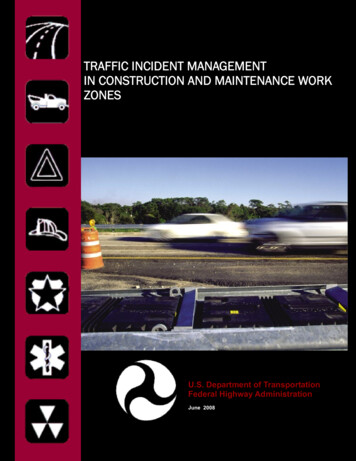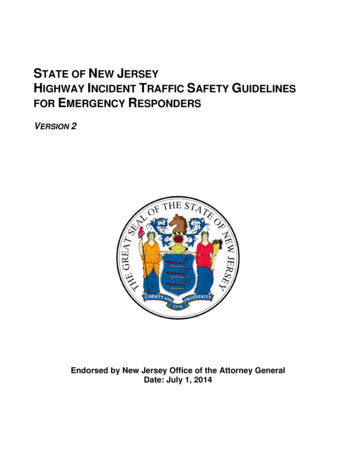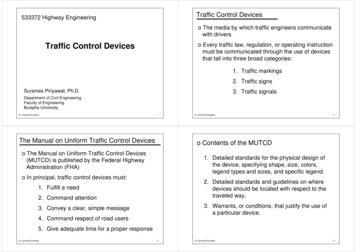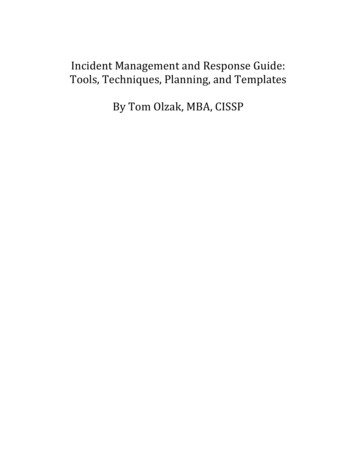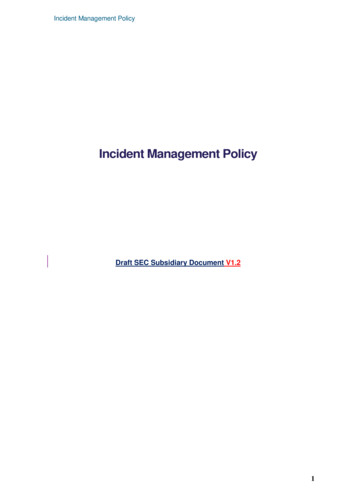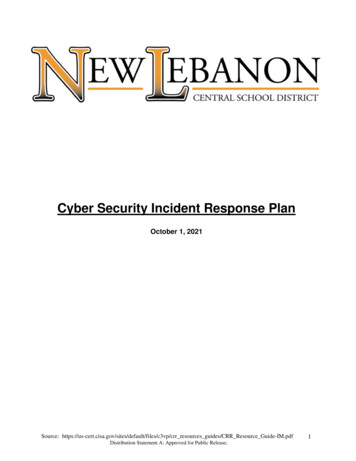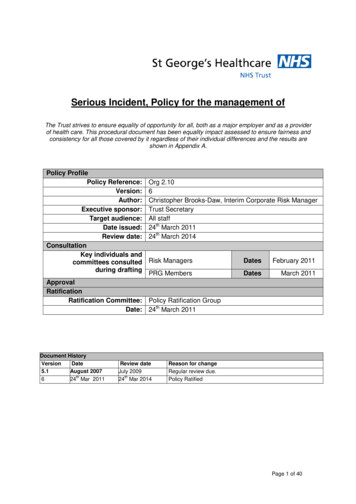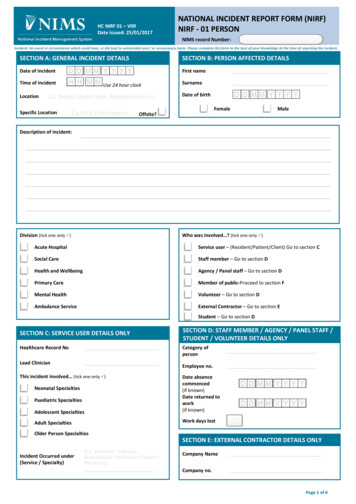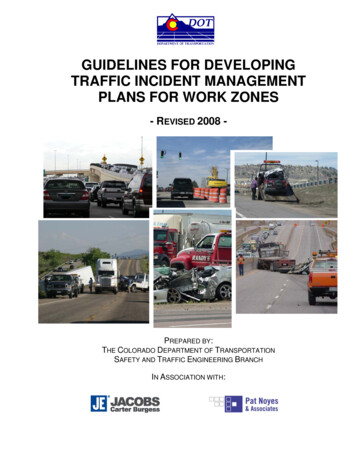
Transcription
I. WHAT IS TRAFFIC INCIDENT MANAGEMENT (TIM)The FHWA’s Freeway Management Operations Handbook(Chapter 10, 2003), describes traffic incident management as:The systematic, planned, and coordinated use of human,institutional, mechanical, and technical resources to reduce theduration and impact of traffic incidents, and improve the safety ofcrash victims, traffic incident responders, and motorists.Effectively using these resources can also increase theoperating efficiency, safety, and mobility of the highway. Thisresults from reducing the time to detect and verify a traffic incidentoccurrence; implementing the appropriate response; safelyclearing the incident; and managing the affected flow until fullcapacity is restored. Traffic incident management provides acoordinated approach to managing incidents that occur on ourhighways. These guidelines are designed to help develop trafficincident management plans that will create a safer work zone forall stakeholders.II. INTRODUCTIONA. Goals of Traffic Incident ManagementThe goals of this program are to improve the safety ofresponders at incident scenes along with reducing incidentduration time. Responders and the travelling public are safestwhen traffic is flowing at a normal traffic flow.ALTIM is committed to providing a safe and reliable multimodaltransportation system. Incidents and non-recurring events thatcause a reduction in highway capacity account for nearly 50 to 60percent of total daily congestion delay. In small urban or ruralareas, this number can be significantly higher (FHWA, FreewayManagement Operations Handbook, Chapter 10, 2003). Theseincidents pose a risk of secondary incidents and can causeadditional problems, including increased traveler delay and fuelconsumption, reduced air quality and, when combined with workTRAFFIC INCIDENT MANAGEMENT GUIDELINES1
zones, delays and costs to the construction project. Recent studiesindicate that approximately 50 percent of all highway congestion isattributed to non-recurring conditions (such as traffic incidents,weather, work zones, and special events). (U.S. Department ofEnergy, Temporary Losses of Highway Capacity and Impacts onPerformance, Oak Ridge National Laboratory (ORNL/TM-2002/3),May 2002.)Struck-by incidents, where passing motorists hit responders,are also on the rise. In 2005, the National Institute for OccupationalSafety and Health (NIOSH) reported that 390 workers were killed instruck-by incidents (up from 278 in 2004). That year, struck-byincidents accounted for 7 percent of the total number ofoccupational injuries.In a typical year, the following number of responders are struckand killed: 10 Law Enforcement Officers 4 Fire and Rescue Personnel An estimated 40-60 Towing and Recovery Professionals Several transportation professionals from DOTs, PublicWorks, and Safety Service PatrolPrograms Data on highway workers killed at traffic incidentscurrently is not separated from overall statistics; however, NIOSHestimates struck-by deaths (including workers struck by a passingvehicle, or mobile equipment) accounted for half of the 844 workerdeaths between 1996 and 2002.B. Incident Response Prioritiesa. Priority 1: Life Safety – Initial efforts are to preserve lives,including those of incident victims, responders, and passingmotorists. Safety is the highest priority throughout theincident.b. Priority 2: Incident Stabilization – Using best practices,stabilize the incident scene to prevent fire, eliminateignition sources, contain hazardous materials and stabilizevehicles involved in the incident.TRAFFIC INCIDENT MANAGEMENT GUIDELINES2
i.Prevention of Secondary Incidents – Respondersshould use available traffic control devices and, ifpossible, position apparatus to divert traffic aroundthe crash scene. Special attention should be paid tothe end of the traffic queue, using permanent andportable Changeable Message Signs (CMS) to warnmotorists of slow or stopped traffic as theyapproach the end of the queue.ii. Protection of Evidence – All incident sites arepotential crime scenes and must be treatedaccordingly. Responders must make every effort tominimize the impact of their presence on the crashscene.iii. Safe, Quick Clearance – It should be the goal of allresponders to clear the scene as soon as practicaland to restore traffic flow to limit the diversion oftraffic to less desirable and/or more hazardousroutesc. Priority 3: Protection of Property and the Environment –Responders should attempt to protect and preserve thehigh-way infrastructure and limit damage to vehiclesinvolved in incidents to what is necessary to stabilize andremove victims trapped in the vehicles. Property salvageoperations should be conducted as soon as safely possible.For hazardous materials and/or potential hazardousmaterials scenes, responders with the proper personalprotective equipment and training should strive to containthe spilled product while minimizing exposure.III. INCIDENT LEVELSIncident levels are defined by the extent and duration of theimpact anticipated on the roadway and is consistent with thedefinitions provided in the MUTCD. The purpose of defining levelsTRAFFIC INCIDENT MANAGEMENT GUIDELINES3
is to help identify appropriate actions to be taken in response tothe anticipated level of impact. Common use of levels also helpsresponders and those responsible for disseminating informationimmediately understand the magnitude of the incident. Thefollowing incident levels have been adopted as standard definitionsfor use throughout Alabama:A. Minor (Level 1): Impact to traveled roadway estimated tobe less than 30 minutes with no lane blockage.B. Intermediate (Level 2): Impact to traveled roadwayestimated to be greater than 30 minutes, but less than 2hours with lane blockages, but not a full closure of theroadway.C. Major (Level 3): Congestive impact to traveled roadway isestimated to be greater than 2 hours or roadway is fullyclosed in any single direction.D. Major – Long Term Closure (Level 4): Extended closuregreater than 24 hours. Closure duration shall be determinedby the incident commander.The purpose of defining levels is not to create additional burdento the incident manager or initial responder, but to provideconsistent actions and support based on the level of impact.While an initial size-up may indicate a minor incident that couldbe cleared in less than 30 minutes, subsequent information, suchas a hazardous materials situation or a fatality, may change whatwas initially thought to be a minor incident to a more complexresponse with more significant impacts to the roadway.IV.SCENE SIZE-UPAs soon as practical upon arriving at the scene of a trafficincident the first responder should provide the emergencyoperations/dispatch center with the information outlined below.As much information as possible should be provided before initiallyexiting the response vehicle:TRAFFIC INCIDENT MANAGEMENT GUIDELINES4
1. Location of incident:(a) County.(b) Route.(c) Mile Post/nearest intersection.(d) Direction (NB, SB, EB, WB).2. Incident type (fire, flood, hazardous material spill, etc.).3. Type of hazardous materials involved (if any).4. Impacts to traffic (number of lanes blocked, etc.)5. Vehicle information (number and type of vehicles involved,level of damage).6. Number of persons potentially affected by the incident.7. Anticipated threat/hazards to emergency responders.8. Lead agency.9. Resources needed:(a) Personnel.(b) Vehicles.(c) Equipment/Supplies.10. Location of the Incident Command Post (ICP) or staging area(if established).11. Ingress/egress routes.TRAFFIC INCIDENT MANAGEMENT GUIDELINES5
TRAFFIC INCIDENT MANAGEMENT GUIDELINES6
V. AGENCY IDENTIFICATION AND RESPONSIBILITIESTypical incident management responsibilities applicable to allbranches include:a. Protect the incident sceneb. Perform first responder dutiesc. Support unified commandd. Clear minor incidentse. Wear appropriate Personal Protective Equipment (PPE),including Safety Vestsf. Preserve evidenceg. Be visible at all timesA. ALDOT/Public Works/County Highway DepartmentsALDOT personnel with a specific interest in traffic incidentmanagement include the Region Traffic Engineer, AreaMaintenance Engineer, special response teams, and the trafficmanagement centers.At the local level, cities and counties that have transportationor road maintenance and operations personnel who would beimpacted by detours and who could provide resources in the eventof an incident.Incident management responsibilities include:a. Monitor Traffic Operationsb. Perform incident detection and verificationc. Establish Temporary Traffic Control Zoned. Implement traffic control strategies and provide supportingresourcese. Disseminate motorist informationf. Assess and direct incident clearance activities under aunified command structureg. Develop and operate alternate routesh. Assess and perform emergency roadwork andinfrastructure repairTRAFFIC INCIDENT MANAGEMENT GUIDELINES7
i.Remain at the incident scene until the tow truck or lastresponder has left the scene, unless law enforcementprovides that coveragej. Support unified command as necessary.k. Protect incident scenel. Clear minor incidentsm. Mitigate small vehicle fluid spillsB. Law EnforcementAlabama Law Enforcement Agency generally has jurisdiction onstate highways in Alabama. Local law enforcement, police andsheriff, also respond to traffic incidents on state highways and insome locations may have primary jurisdiction. It is important tocoordinate with law enforcement at all levels to determine theirneeds in managing incidents.Incident management responsibilities include:a. Secure incident sceneb. Assist responders in accessing the incident scenec. Establish emergency access routesd. Control arrival and departure of incident responderse. Police perimeter of incident scene and impact areaf. Conduct incident investigationg. Establish Temporary Traffic Control Zoneh. Perform traffic controli. Remain at the incident scene until the tow truck or otherlast responder has left the scene, unless the roadwayagency provides that coveragej. Protect incident scene.k. Support unified command as necessary.C. Fire/RescueFire/rescue response is generally provided by local firedepartments. These departments may have volunteer or careerresponders, or a combination thereof. It is important to work withthese agencies to determine their needs and understand theircurrent practices and protocols.TRAFFIC INCIDENT MANAGEMENT GUIDELINES8
Incident management responsibilities include:a. Rescue/extricate victimsb. Extinguish firesc. Stabilize and render safe crash damaged vehiclesd. Assess incidents involving a hazardous materials releasee. Contain or mitigate a hazardous materials releasef. Mitigate minor fluid spillsg. Establish and monitor Temporary Air Medical (Medevac)Landing Zonesh. Support unified command as necessary.D. Towing and RecoveryTowing and recovery services are responsible for the safe andefficient removal of wrecked or disabled vehicles, and debris fromthe incident scene. Towing and recovery services are generallyprovided by private companies. Towing services are oftenmaintained on a rotation list by Law Enforcement agencies forresponse on state highways. In some locations in Alabama, ALDOThas a standing contract with Towing companies to provide servicesin certain areas during peak traffic times.Incident management responsibilities include:a. Evaluate scene safety with other responders, discussingrecovery proceduresb. Provide technical assistance/information to otherresponding stakeholdersc. Mitigate minor fluid spillsd. Apply absorbents and remove debris/spilled fluids from theroadwaye. Perform recovery by re-aligning the vehicle to tow truck,not tow truck to vehicle, using snatch blocks or othertechniques, when able to do so safelyf. Perform recoveries in one lane, if possible, and load vehiclefor transportg. Clean up debris and used absorbents. Do not place debrisand absorbents in the vehicleTRAFFIC INCIDENT MANAGEMENT GUIDELINES9
h. Return roadway to pre-incident condition as well aspossiblei. Check in with other responders prior to departing the scenej. Transport occupants of the vehicle to a safe location afterthe vehicle is removed from the roadwayk. Support unified command as necessary.E. Emergency Medical ServiceEmergency medical service (EMS) is generally provided by firedepartments or ambulance services. The primary responsibilities ofEMS are the triage, treatment, and transport of victims.Incident management responsibilities include:a. Provide medical treatment to those injured at the incidentsceneb. Determine destination and transportation requirements forinjured victimsc. Coordinate evacuation with fire, police, and ambulance orairliftd. Transport victims for additional medical treatmente. Provide medical monitoring and rehabilitation foremergency respondersf. Support unified command as necessary.F. Hazardous MaterialsHazardous materials incidents fall under the jurisdiction of theAlabama Emergency Management Agency or the local county EMA.These are the agencies with legal authority to respond to andmanage hazardous materials incidents. In many urban areas, thelocal fire department has a Hazardous Response Unit. In more ruralareas or locations without local expertise in hazardous materials,this does not exist.Incident management responsibilities include:a. Contain and remove hazardous wasteb. Mitigate on-going release of material into the environment.TRAFFIC INCIDENT MANAGEMENT GUIDELINES10
c. Coordinate with other responders to arrange for theremoval of collected hazardous waste to a location off ofthe traveled way.G. MediaThe media can be an essential resource in informing thetraveling public of incidents. Broadcast media, such as radio andtelevision, can provide real-time information, allowing drivers tomake informed decisions about their travel. Other media services,such as internet and paging services, can provide time-sensitiveinformation. Local media services should be identified andcoordinated with to provide effective incident management.Incident management responsibilities include:a. Check in with law enforcement or ALDOT to determine thesafest location to perform media responsibilities. Preferablynot from opposite lanes or directions.b. Do not impede the flow of traffic.c. Abide by Alabama Law and stay a minimum of 500’ from thenearest emergency vehicle, unless directed to a designatedmedia area by law enforcement or ALDOT. (Code ofAlabama Section 32-5A-58)H. Other StakeholdersA number of other stakeholders may exist in an incident andcould have an impact on how incidents are managed. Some localgovernments or quasi-governmental agencies provide specializedrescue services, such as extrication of patients from badly damagedvehicles. Rescue squads/special dive teams may be needed forincidents that involve patients in rivers that run parallel to anumber of highways in Alabama. Victims of fatal crashes cannot bemoved until the Traffic Homicide Investigator is on-scene. Incidentsinvolving livestock will often require a veterinarian for euthanizinganimals that are injured along with the appropriate personnel(cowboys) to offload the remaining livestock along with livestocktrailers to load the livestock onto.TRAFFIC INCIDENT MANAGEMENT GUIDELINES11
VI. UNIFIED COMMAND AND MULTI-DISCIPLINARYAPPROACHIncidents requiring the response of multiple stakeholders willbe managed via a Unified Command (UC). As such, each respondingdiscipline will send a representative to the Unified Command Post(if such is designated), where they will work cooperatively andwithin their respective areas of expertise to safely and effectivelymitigate the incident. Decisions will be communicated amongst allstakeholder representatives to ensure coordination of efforts. Asuccessful traffic incident management program requires strong,inter-agency involvement and commitment. Incidents require ahigh level of collaboration and coordination to meet the safety andmobility needs of all stakeholders. All agencies responding toincidents must be involved to ensure that their specific needs aremet and help ensure a successful TIM implementation.UC allows agencies representing different jurisdictions orfunctional responsibilities to coordinate, plan, and interacteffectively without loss of individual agency authority,responsibility, or accountability. UC is intended to jointlyaccomplish the following tasks: Determine incident objectives (in priority order) Establish strategies to accomplish the objectives. Establish ICS organizational elements as necessary Resolve any outstanding issues affecting UC managementAdvantages of Using Unified Command A single set of objectives is developed for an entire incident. A collective approach is used to develop strategies toachieve incident objectives. Information flow and coordination are improved betweenall jurisdictions and agencies involved in the incident. All agencies with responsibility for the incident understandjoint priorities and restrictions. No agency’s legal authority is compromised or neglected.TRAFFIC INCIDENT MANAGEMENT GUIDELINES12
Each agency has complete knowledge of the plans, actions,and constraints of all other agencies.The combined efforts and resources of all agencies areoptimized as they perform their respective assignmentsunder a single IAP (Incident Action Plan).Duplicative efforts are reduced or eliminated, therebyincreasing the overall cost-effectiveness of the effort andminimizing potential conflictsVII. GENERAL SAFETY AND RISK MANAGEMENTChapter 6 of the Manual on Uniform Traffic Control Devices(MUTCD) states “The primary function of [Temporary TrafficControl] TTC is to provide for the reasonably safe and efficientmovement of road users through or around TTC zones whilereasonably protecting workers, responders to traffic incidents, andequipment.” Chapter 6 includes requirements and guidance on alltemporary traffic control associated with work zones and the trafficincidents. One of the principles for temporary traffic control is todevelop “general plans or guidelines to provide safety orcement/emergency officials, and equipment. Responders toroadway incidents must maintain a constant awareness of theinherent danger of operating on roadways. While completelyclosing the roadway whenever an incident occurs may seem thesafest option, it can cause a myriad of problems and complications: The number of personnel needed to safely and effectivelyclose the highway or roadway. The greatly increased chance of secondary crashes, both onthe affected roadway and on secondary roads not designedfor the increased traffic volume. The likely delay for additional emergency units attemptingto access the incident scene.TRAFFIC INCIDENT MANAGEMENT GUIDELINES13
Significant traffic congestion in a large geographic area,impeding responses to additional emergency incidentswhich may occur.Therefore, police and other emergency responders must workcooperatively to employ the necessary traffic diversions toestablish a safe work zone for responders, without unnecessarilyrestricting the flow of traffic through the area. TRAFFIC INCIDENT MANAGEMENT GUIDELINES14
Each responder at an incident must be constantly aware of hisor her personal safety. While traffic control devices and visibilityenhancing garments will increase your safety, they will not protectyou from a driver who loses control of their vehicle and/or is notpaying attention to the road. Therefore, your greatest protection isto keep a physical barrier (blocker vehicle, guardrail, crash vehicles,etc.) between you and moving traffic whenever possible.TRAFFIC INCIDENT MANAGEMENT GUIDELINES15
The following are additional protective measures you can taketo maximize your protection at an incident scene. Be safe. Act safe.A. In accordance with Federal Regulation 23 CFR 634, allemergency workers operating on a roadway who areexposed to traffic shall wear a Class II or higher vestcomplying with ANSI/ISEA 107, 2004 or 2006 or a PublicSafety Vest complying with ANSI/ISEA 207, 2006.Firefighters or other emergency responders engaged inemergency operations that directly expose them to flame,fire, heat, and/or hazardous materials are not required towear a vest, provided they are attired in retro-reflectiveturn-out gear that is specified and regulated by otherorganizations, such as the National Fire ProtectionAssociation.B. Notwithstanding the visibility requirements describedabove, fire department members are expected to wear fullPersonal Protective Equipment (coat, pants, helmet) whileoperating on the roadway. As noted above, an approvedClass II vest must be worn over the coat (unless the abovedescribed exemption criteria is met). The IC may allowfirefighters to remove their coats after the hazard has beenmitigated, however, the Class II vest must still be worn.C. Responders shall never operate in a live lane. Crossing a livelane should be done with extreme caution and should beavoided when possible.D. Hose lines/equipment should be deployed from theprotected, downstream side (opposite live traffic lanes) ofemergency vehicles whenever possible.E. Do not enter or exit apparatus near or in live lanes of traffic.F. Do not drive against the flow of traffic without lawenforcement approval and confirmation that traffic hasbeen stopped.TRAFFIC INCIDENT MANAGEMENT GUIDELINES16
G. Use designated entrances and exits. Do not use medianturnarounds unless the circumstances pose a risk to life orare otherwise extenuating.H. Shut down forward facing emergency lights to reduceopposite direction incidents.I. Limit the amount of equipment on the roadway, thusreducing your liability exposure. Risk vs. Need.J. Always communicate, coordinate, cooperate, beprofessional, and work within the framework of unifiedcommand.K. Ensure all members are aware of and trained on theseguidelines.VIII. TRAVELER INFORMATIONTraveler information is a critical component of effective trafficincident management. Tools to help inform travelers of an incidentinclude ITS (Intelligent Transportation System) devices (such asvariable message signs and highway advisory radio), publiceducation campaigns and the broadcast media. It is important toinform motorists of current traffic conditions to help minimizefrustration, increase compliance with alternate routes, andenhance safety throughout the incident zone. Furthermore, it isimportant to notify drivers who have not yet entered the highwaysystem. For example, it is imperative to inform those who have notleft for their destination so they can reconsider the amount of timeor route of travel.In addition to using specific tools for informing motorists, thereneed to be procedures outlining responsibilities for updating anddisseminating information. ALDOT’s RTMC’s (Regional TrafficManagement Center) provide a key role in disseminatinginformation to the public and the media. Most RTMC’s are staffed24-hours a day, 365 days a year, with personnel who monitor trafficconditions throughout the state and update ALGO Traffic,TRAFFIC INCIDENT MANAGEMENT GUIDELINES17
permanent variable message signs, and highway advisory radios.Procedures for how to coordinate with the RTMC should beestablished as well as procedures for additional informationactivities to be performed by the response agencies.TRAFFIC INCIDENT MANAGEMENT GUIDELINES18
The FHWA's Freeway Management Operations Handbook (Chapter 10, 2003), describes traffic incident management as: The systematic, planned, and coordinated use of human, institutional, mechanical, and technical resources to reduce the duration and impact of traffic incidents, and improve the safety of crash victims, traffic incident responders .
